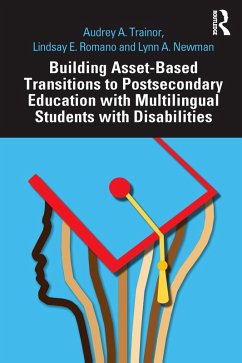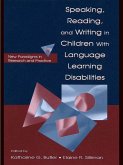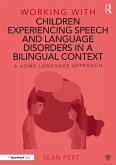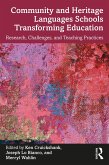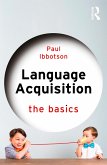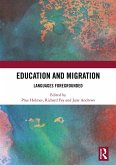Building Asset-Based Transitions to Postsecondary Education with Multilingual Students with Disabilities (eBook, PDF)


Alle Infos zum eBook verschenken

Building Asset-Based Transitions to Postsecondary Education with Multilingual Students with Disabilities (eBook, PDF)
- Format: PDF
- Merkliste
- Auf die Merkliste
- Bewerten Bewerten
- Teilen
- Produkt teilen
- Produkterinnerung
- Produkterinnerung

Hier können Sie sich einloggen

Bitte loggen Sie sich zunächst in Ihr Kundenkonto ein oder registrieren Sie sich bei bücher.de, um das eBook-Abo tolino select nutzen zu können.
This important volume presents the results from a five-year, mixed methods study on the transition from high school to postsecondary education for young adults who, during secondary school, received both English learner and special education services. It aims to improve our understanding of, and thus the supportive service provisions for, the dually identified student population in secondary and higher education settings. The book explores dually identified students' complex and intersectional experiences, strengths, and needs using multiple methods of inquiry, including the examination of…mehr
- Geräte: PC
- mit Kopierschutz
- eBook Hilfe
![Building Asset-Based Transitions to Postsecondary Education with Multilingual Students with Disabilities (eBook, ePUB) Building Asset-Based Transitions to Postsecondary Education with Multilingual Students with Disabilities (eBook, ePUB)]() Audrey A. TrainorBuilding Asset-Based Transitions to Postsecondary Education with Multilingual Students with Disabilities (eBook, ePUB)41,95 €
Audrey A. TrainorBuilding Asset-Based Transitions to Postsecondary Education with Multilingual Students with Disabilities (eBook, ePUB)41,95 €![Speaking, Reading, and Writing in Children With Language Learning Disabilities (eBook, PDF) Speaking, Reading, and Writing in Children With Language Learning Disabilities (eBook, PDF)]() Speaking, Reading, and Writing in Children With Language Learning Disabilities (eBook, PDF)56,95 €
Speaking, Reading, and Writing in Children With Language Learning Disabilities (eBook, PDF)56,95 €![Working with Children Experiencing Speech and Language Disorders in a Bilingual Context (eBook, PDF) Working with Children Experiencing Speech and Language Disorders in a Bilingual Context (eBook, PDF)]() Sean PertWorking with Children Experiencing Speech and Language Disorders in a Bilingual Context (eBook, PDF)35,95 €
Sean PertWorking with Children Experiencing Speech and Language Disorders in a Bilingual Context (eBook, PDF)35,95 €![Community and Heritage Languages Schools Transforming Education (eBook, PDF) Community and Heritage Languages Schools Transforming Education (eBook, PDF)]() Community and Heritage Languages Schools Transforming Education (eBook, PDF)39,95 €
Community and Heritage Languages Schools Transforming Education (eBook, PDF)39,95 €![Language Acquisition (eBook, PDF) Language Acquisition (eBook, PDF)]() Paul IbbotsonLanguage Acquisition (eBook, PDF)19,95 €
Paul IbbotsonLanguage Acquisition (eBook, PDF)19,95 €![Education and Migration (eBook, PDF) Education and Migration (eBook, PDF)]() Education and Migration (eBook, PDF)41,95 €
Education and Migration (eBook, PDF)41,95 €![Understanding Signed Languages (eBook, PDF) Understanding Signed Languages (eBook, PDF)]() Erin WilkinsonUnderstanding Signed Languages (eBook, PDF)38,95 €
Erin WilkinsonUnderstanding Signed Languages (eBook, PDF)38,95 €-
-
-
Dieser Download kann aus rechtlichen Gründen nur mit Rechnungsadresse in A, B, BG, CY, CZ, D, DK, EW, E, FIN, F, GR, HR, H, IRL, I, LT, L, LR, M, NL, PL, P, R, S, SLO, SK ausgeliefert werden.
- Produktdetails
- Verlag: Taylor & Francis eBooks
- Seitenzahl: 204
- Erscheinungstermin: 30. September 2024
- Englisch
- ISBN-13: 9781040152386
- Artikelnr.: 72276197
- Verlag: Taylor & Francis eBooks
- Seitenzahl: 204
- Erscheinungstermin: 30. September 2024
- Englisch
- ISBN-13: 9781040152386
- Artikelnr.: 72276197
- Herstellerkennzeichnung Die Herstellerinformationen sind derzeit nicht verfügbar.
Lindsay E. Romano, MS, is a former high school special education teacher and current doctoral candidate at New York University. Her research aims to disrupt inequities at the intersections of racism, ableism, and linguicism, studying how teachers perpetuate/disrupt inequities and how mindfulness-based practices can advance social justice in classrooms.
Lynn A. Newman, EdD, Principal Education Researcher at SRI International, has more than 30 years of research experience focused on improving access and opportunity for students and young adults with disabilities through identifying the high school and postsecondary experiences linked to positive outcomes for all individuals with disabilities.
Disclaimer
Acknowledgements
Introduction
1) Chapter 1: Our Five-Year, Mixed Methods Study of Dually Identified
Students: Research Direction, Design, and Decisions
a) Situating the Study
i) A Brief History of Special and Bilingual/EL Education Research and
Policy
ii) Background on Special and EL Education
b) Our Multiyear Mixed Methods Study
i) Mixed Methods Study: Quantitative Research Component
ii) Mixed Methods Study: Qualitative Research Component
(1) Implementing Qualitative Research in Times of Duress
(2) Recruitment, Data Collection, and Data Analysis
c) Limitations and Implications
d) Researcher Reflections
e) Discussion Questions
f) Suggestions for Further Reading
2) Chapter 2: Navigating Multiple Service Systems: How College and Career
Ready Are Dually Identified High School Students?
a) The Expected Paths to Adulthood
b) The Role of College and Career Readiness in Postschool Transitions
i) Expectations
ii) Secondary Education Experiences
(1) Employment
(2) High School Curricula
(3) Instructional Classroom Contexts
iii) Access to Postsecondary Education
c) Methodological and Theoretical Considerations
d) Study Results
i) The National Sample
ii) The NYC Sample
(1) Classroom Contexts
(2) Stakeholders' Perceptions of Contexts
(3) Preparedness and Outcomes
e) Limitations and Implications
i) Implications for Research
ii) Implications for Practice
f) Researcher Reflections
g) Discussion Questions
h) Suggestions for Further Reading
3) Chapter 3: Looking Through the Lenses of Identity Theories: How Do
Students Navigate the Affordances and Liabilities of Labeling?
a) The Roles of Language and Learner Identities in Postsecondary Transition
b) The Multidimensionality and Fluidity of Multilingual Learners
i) Vulnerability and Protection Associated with Perceptions and Attitudes
ii) Vulnerability and Protection Associated with Systems and Structures
c) Methodological and Theoretical Considerations
i) Data Collection and Analysis
ii) Theoretical Anchors
d) Study Results
i) Protective Factors Associated with Learning Multiple Languages
ii) Vulnerabilities Linked to Ambivalence and Resource Availability
iii) Protection and Vulnerability Associated with Moving Forward
iv) A Broader View of Vulnerabilities and Protective Intersectional Factors
e) Limitations and Implications
f) Researcher Reflections
g) Discussion Questions
h) Suggestions for Further Reading
4) Chapter 4: School-Home Collaborations: Navigating Distance and Finding
Common Ground
a) The Promise of School-Home Connections in Transition Planning
b) The Role of Teachers in Building Home-School Collaborations
c) School-Home Collaborations for Dually Identified Youth
i) Extended Family and Siblings
ii) Self-determination
iii) Community Cultural Wealth
d) Methodological and Theoretical Considerations
e) Study Results
i) Conflicting Interests
ii) Language Learning
iii) Siblings and Extended Family
iv) Developing Self-Determination
f) Limitations and Implications
g) Researcher Reflections
h) Discussion Questions
i) Suggestions for Further Reading
5) Chapter 5: Being Supported and Belonging in Postsecondary Education: The
Availability of Disability- and EL-Focused Resources
a) The Challenge of Postsecondary Education
b) Transition to Postsecondary Education
i) Examining Preparedness and Enrollment
ii) Examining Engagement and Degree Completion
iii) Understanding the Amplified Role of Cost
c) Methodological and Theoretical Considerations
i) Sample and Recruitment
ii) Data Collection and Analysis
d) Study Results
i) Identifying and Seeking Services and Supports
ii) ODAS Supports for Sustaining Engagement
iii) Lingering Stigma Associated with Identification
iv) Faculty as Gatekeepers
e) Limitations and Implications
i) Implications for Research
ii) Implications for Practice
f) Researcher Reflections
g) Discussion Questions
h) Suggestions for Further Reading
Conclusion
References
Index
Disclaimer
Acknowledgements
Introduction
1) Chapter 1: Our Five-Year, Mixed Methods Study of Dually Identified
Students: Research Direction, Design, and Decisions
a) Situating the Study
i) A Brief History of Special and Bilingual/EL Education Research and
Policy
ii) Background on Special and EL Education
b) Our Multiyear Mixed Methods Study
i) Mixed Methods Study: Quantitative Research Component
ii) Mixed Methods Study: Qualitative Research Component
(1) Implementing Qualitative Research in Times of Duress
(2) Recruitment, Data Collection, and Data Analysis
c) Limitations and Implications
d) Researcher Reflections
e) Discussion Questions
f) Suggestions for Further Reading
2) Chapter 2: Navigating Multiple Service Systems: How College and Career
Ready Are Dually Identified High School Students?
a) The Expected Paths to Adulthood
b) The Role of College and Career Readiness in Postschool Transitions
i) Expectations
ii) Secondary Education Experiences
(1) Employment
(2) High School Curricula
(3) Instructional Classroom Contexts
iii) Access to Postsecondary Education
c) Methodological and Theoretical Considerations
d) Study Results
i) The National Sample
ii) The NYC Sample
(1) Classroom Contexts
(2) Stakeholders' Perceptions of Contexts
(3) Preparedness and Outcomes
e) Limitations and Implications
i) Implications for Research
ii) Implications for Practice
f) Researcher Reflections
g) Discussion Questions
h) Suggestions for Further Reading
3) Chapter 3: Looking Through the Lenses of Identity Theories: How Do
Students Navigate the Affordances and Liabilities of Labeling?
a) The Roles of Language and Learner Identities in Postsecondary Transition
b) The Multidimensionality and Fluidity of Multilingual Learners
i) Vulnerability and Protection Associated with Perceptions and Attitudes
ii) Vulnerability and Protection Associated with Systems and Structures
c) Methodological and Theoretical Considerations
i) Data Collection and Analysis
ii) Theoretical Anchors
d) Study Results
i) Protective Factors Associated with Learning Multiple Languages
ii) Vulnerabilities Linked to Ambivalence and Resource Availability
iii) Protection and Vulnerability Associated with Moving Forward
iv) A Broader View of Vulnerabilities and Protective Intersectional Factors
e) Limitations and Implications
f) Researcher Reflections
g) Discussion Questions
h) Suggestions for Further Reading
4) Chapter 4: School-Home Collaborations: Navigating Distance and Finding
Common Ground
a) The Promise of School-Home Connections in Transition Planning
b) The Role of Teachers in Building Home-School Collaborations
c) School-Home Collaborations for Dually Identified Youth
i) Extended Family and Siblings
ii) Self-determination
iii) Community Cultural Wealth
d) Methodological and Theoretical Considerations
e) Study Results
i) Conflicting Interests
ii) Language Learning
iii) Siblings and Extended Family
iv) Developing Self-Determination
f) Limitations and Implications
g) Researcher Reflections
h) Discussion Questions
i) Suggestions for Further Reading
5) Chapter 5: Being Supported and Belonging in Postsecondary Education: The
Availability of Disability- and EL-Focused Resources
a) The Challenge of Postsecondary Education
b) Transition to Postsecondary Education
i) Examining Preparedness and Enrollment
ii) Examining Engagement and Degree Completion
iii) Understanding the Amplified Role of Cost
c) Methodological and Theoretical Considerations
i) Sample and Recruitment
ii) Data Collection and Analysis
d) Study Results
i) Identifying and Seeking Services and Supports
ii) ODAS Supports for Sustaining Engagement
iii) Lingering Stigma Associated with Identification
iv) Faculty as Gatekeepers
e) Limitations and Implications
i) Implications for Research
ii) Implications for Practice
f) Researcher Reflections
g) Discussion Questions
h) Suggestions for Further Reading
Conclusion
References
Index
